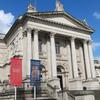More about Christ in the House of His Parents
- All
- Info
- Shop

Contributor
Christ in the House of His Parents is a family portrait with some pretty gloomy religious foreshadowing.
Despite the ultimately funereal subject, John Everett Millais created a deeply narrative painting of what appears to be a normal family handling a little work accident. As we can all probably figure out, this isn’t just any family, but the holy family. The painting, originally displayed without a title, was accompanied by a biblical verse, the very verse in the Old Testament that prefigures the Crucifixion of Christ: “And one shall say unto him, what are those wounds in thine hands? Then shall he answer. Those with which I was wounded in the house of my friends.” Millais just backtracked further and gave a whole lot of omens to young Christ, including traditional religious symbolism: the white dove, the Holy Trinity carpenter’s triangle and even the blood on young Christ’s foot and hand. If you still didn’t get it at that point, it really could be a painting of a normal, albeit clumsy, family.
Millais and his PRB brethren were all about truth to nature. So it comes as no surprise that Millais wanted to paint the holy family with that credo. He was so intent upon using nature that he used two real sheep heads from the butcher’s shop to create Christ’s “flock,” avoided professional models by using his friends and family, and painted an actual carpenter’s shop on Oxford Street. In his determination to feel the reality, Millais sketched and painted on location at the carpenter’s shop beginning in November 1849 and ended up catching a cold before showing the finished canvas in April 1850.
For Millais, placing these holy symbols in everyday life made the depiction beautiful. However, this sentiment was very much lost on the art critics of the period. The public reacted in horror to the normality with which Millais painted the holy family and the prefiguring of Christ’s Crucifixion. The Times called the work “revolting,” and Charles Dickens described the young Christ in the painting as “a hideous, wry-necked, blubbering, red-haired boy in a bed gown.”
The public is never quite prepared for cultural change and Millais pushed the boundary by rejecting the idealized religious imagery of the day and creating an everyday, and many said homely, portrayal of Christ’s childhood. Millais was still the Royal Academy’s young darling, so Christ in the House of His Parents was exhibited for the whole British world to see. There was such controversy surrounding the painting that Queen Victoria asked to have it removed from the exhibition and brought to her to examine in royal privacy.
Despite Millais, and the PRB, making quite a few enemies with these paintings touting the beauty of nature, Millais made quite the splash in the British art world. Not only did the Queen need to see his work, but he got a scathing review from Charles Dickens, and everybody knows that a scathing review from Charles Dickens is still a review from Charles Dickens. And although Dickens detested the PRB and their credo, he accidentally praised the technical beauty of the painting. So the homely holy family became famous, and so did Millais and the PRB.
Sources
- Dickens, Charles. “Old Lamps for New Ones.” Household Words 12 (15 June, 1850), 12-14. http://www.engl.duq.edu/servus/PR_Critic/HW15jun50.html
- Easby, Rebecca Jeffrey. “Sir John Everett Millais, Christ in the House of His Parents.” Khan Academy. Khan Academy, 2017. 11 October 2017. https://www.khanacademy.org/humanities/becoming-modern/victorian-art-ar…
- McKiernan, Mike. “Sir John Everett Millais Christ in the House of His Parents (The Carpenter’s Shop).” Occupational Medicine, Volume 59, Issue 5, 1 August 2009, Pages 294–295. Web. 11 October 2017. https://academic.oup.com/occmed/article/59/5/294/1410390/
- Landow, George P. “Chapter 4, Part II. Millais’s Christ in the House of His Parents.” in Victorian Types, Victorian Shadows; Biblical Typology in Victorian Literature, Art, and Thought. Routledge & Kegan Paul, 1980.
Featured Content
Here is what Wikipedia says about Christ in the House of His Parents
Christ in the House of His Parents (1849–50) is a painting by John Everett Millais depicting the Holy Family in Saint Joseph's carpentry workshop. The painting was extremely controversial when first exhibited, prompting many negative reviews, most notably one written by Charles Dickens. It catapulted the previously obscure Pre-Raphaelite Brotherhood to notoriety and was a major contributor to the debate about Realism in the arts. It is now in Tate Britain in London.
Check out the full Wikipedia article about Christ in the House of His Parents















I enjoy looking at this picture because while, in my head I know Jesus was a child once, I never have taken the time to actually imagine it. This picture brings that story to a visual level. One element of this painting that drew my eye was the wood shavings on the floor, Millais did a great job of bringing that little detail out that I would not have ever instinctively think about adding something like that.